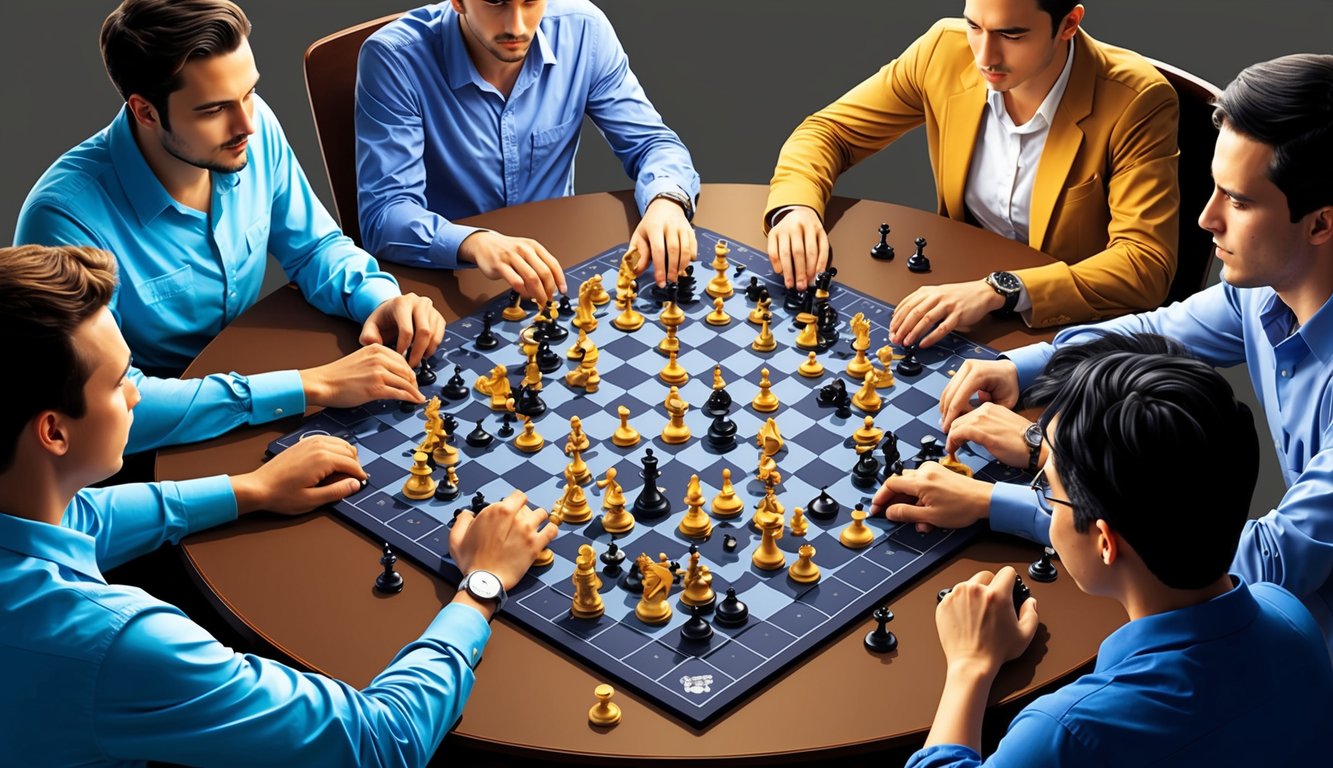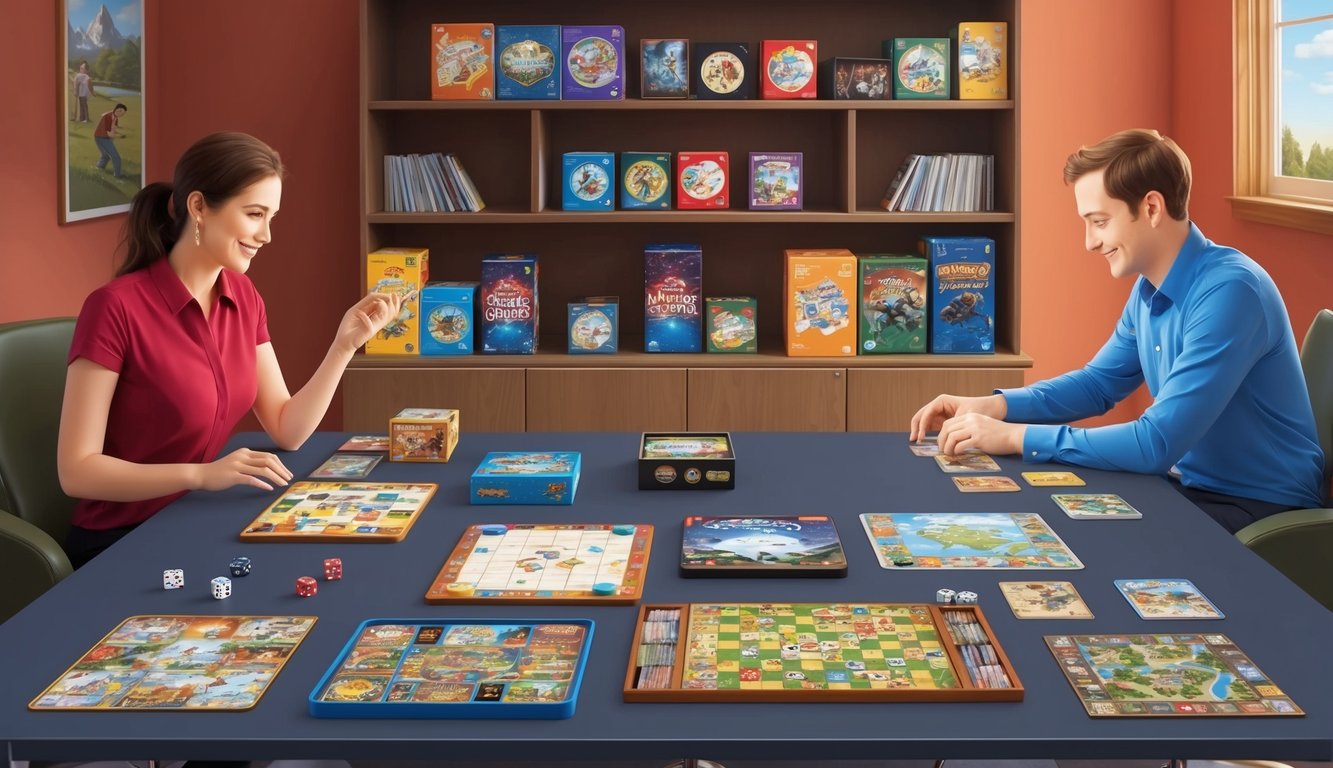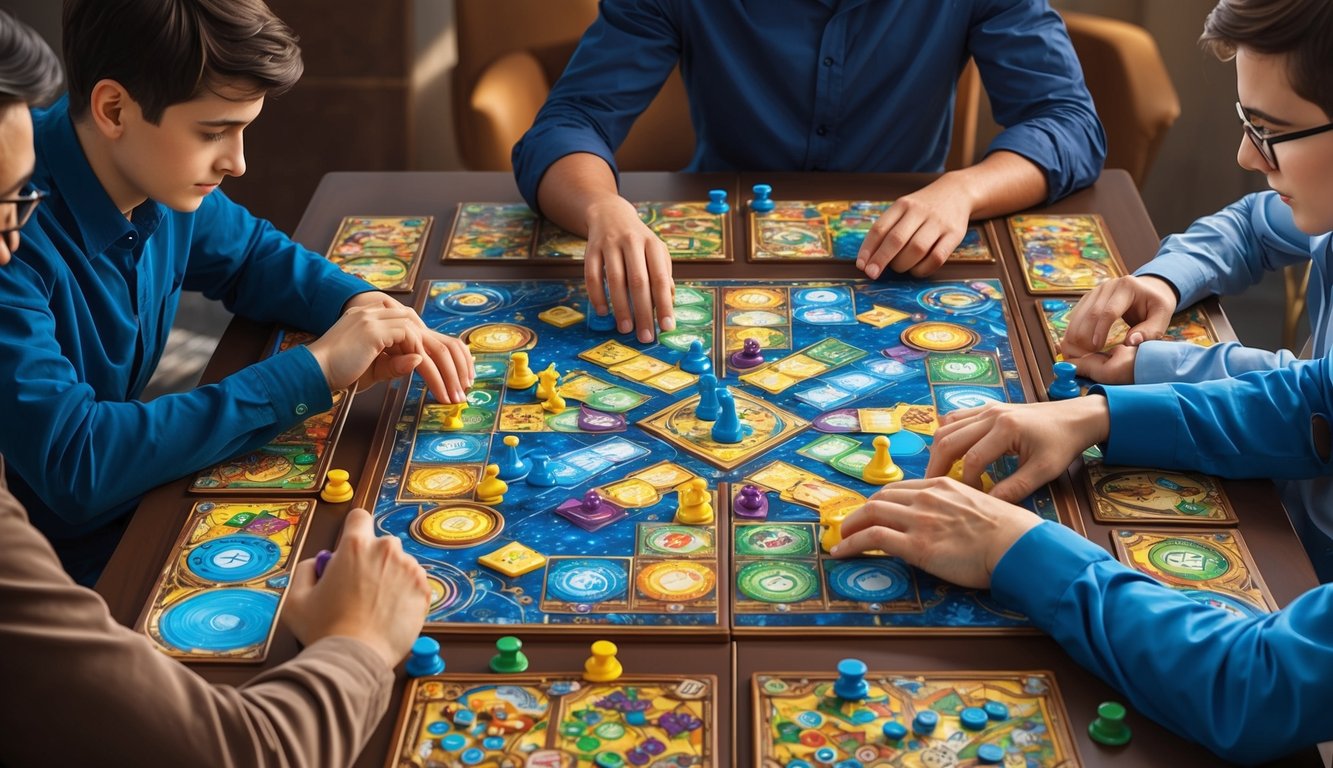Strategy board games offer a thrilling mental challenge that can captivate players for hours.
These games require careful planning, tactical thinking, and adaptability to outmaneuver opponents.
Whether you’re a fan of classic titles like Chess and Risk or prefer modern gems like Wingspan and Scythe, strategy board games provide endless opportunities to test your wits and decision-making skills.

You’ll find a wide variety of themes and mechanics in the world of strategy games.
Classic games often focus on territorial control or resource management, while modern designs introduce innovative concepts like hidden movement or unique player powers.
From building civilizations to exploring alien planets, these games transport you to fascinating worlds where your choices shape the outcome.
Ready to dive into the world of strategy board games? You’re in luck! There’s never been a better time to explore this hobby.
With options ranging from quick 30-minute battles to epic multi-hour campaigns, you’re sure to find games that fit your schedule and preferences.
Whether you’re looking for intense competition or collaborative problem-solving, strategy board games offer something for everyone.
History and Evolution
Strategy board games have captivated players for millennia, evolving from ancient royal pastimes to globally popular entertainment.
These games have shaped cultures, reflected societal structures, and challenged minds across generations.
From Ancient Times to Modern Days
You might be surprised to learn that strategy games date back over 5,000 years.
The Royal Game of Ur, discovered in Mesopotamia, was played around 2600 BC.
It featured an ornate board and unique gameplay.
Ancient Egypt gave us Senet, a game that symbolized the journey to the afterlife.
In China, Go emerged over 2,500 years ago, emphasizing territory control and long-term planning.
Chess, arguably the most famous strategy game, evolved from earlier Indian games.
It spread across cultures, with pieces representing medieval society.
Rise of the Strategy Genre
The 20th century saw strategy games explode in popularity.
Risk, introduced in 1957, brought global conquest to tabletops everywhere.
You’ve probably noticed the recent board game renaissance.
Modern classics like Settlers of Catan have reignited interest in strategy games.
Today’s games blend traditional elements with new mechanics.
They cover diverse themes from sci-fi to economics.
Digital versions have made strategy games more accessible than ever.
You can now play chess or Go against AI opponents or friends worldwide.
Defining Strategy in Board Games
Strategy board games challenge you to think ahead and outmaneuver opponents.
They demand careful planning and thoughtful decision-making to achieve victory.
Strategic Depth and Complexity
Strategy games offer varying levels of complexity.
Some have simple rules but deep strategic possibilities.
Others present intricate systems with many moving parts.
You’ll find games that focus on resource management, area control, or engine building.
Each type tests different strategic skills.
As you play, you’ll need to adapt your plans to changing board states.
This keeps even familiar games feeling fresh and challenging.
The best strategy games reward repeated plays.
You’ll discover new tactics and refine your approach with experience.
Decision-Making Skills and Critical Thinking
Playing strategy board games sharpens your decision-making abilities.
You’ll face tough choices with limited information.
Critical thinking is key.
You must analyze the current situation and predict future outcomes.
You’ll learn to weigh risks and rewards.
Sometimes a bold move pays off, while other times patience is best.
These games teach you to plan several steps ahead.
You’ll consider not just your next action, but how it sets up future turns.
As you improve, you’ll start to recognize patterns and develop problem-solving strategies that apply across different games.
Iconic Strategy Board Games
Strategy board games have captivated players for generations with their blend of skill, tactics, and competition.
From timeless classics to modern favorites, these games challenge your mind and provide hours of entertainment.
Classic Games and Their Legacy
Chess reigns supreme as the quintessential strategy game.
With its origins dating back centuries, it continues to challenge players of all skill levels.
You’ll find yourself constantly adapting your tactics as you maneuver your pieces across the board.
Risk, the game of global domination, has been a staple since 1957.
You’ll spend hours plotting your conquests and forging alliances as you aim to control territories across the world map.
Monopoly, while often contentious, remains an iconic strategy game.
You’ll wheel and deal your way to real estate supremacy, carefully managing your funds and properties to bankrupt your opponents.
Contemporary Strategy Favorites
Catan, also known as Settlers of Catan, revolutionized strategy gaming in the 1990s.
You’ll gather resources, build settlements, and trade with other players in this engaging game of expansion and development.
Twilight Struggle pits you against an opponent in a tense recreation of the Cold War.
You’ll engage in political, military, and economic maneuvering as you vie for global influence.
Ticket to Ride offers a more accessible strategy experience.
You’ll collect train cards and claim railway routes across various maps, balancing risk and reward as you connect distant cities.
Gameplay Mechanics

Strategy board games employ diverse mechanics to create engaging experiences.
Key elements include resource allocation, area control, and player interactions that shape the path to victory.
Let’s explore some core gameplay systems that define this genre.
Worker Placement and Tile-Laying
Worker placement games challenge you to assign limited agents to specific actions or locations.
You’ll need to balance immediate needs with long-term goals.
Popular titles like Agricola task you with managing a farm by strategically placing family members on various tasks.
Tile-laying mechanics add a spatial element to gameplay.
In Carcassonne, you build the game board as you play, placing tiles to create cities, roads, and monasteries.
This mechanic tests your ability to visualize patterns and adapt to an ever-changing landscape.
Both mechanics often intertwine, creating rich decision spaces.
You might place workers to gather resources, then use those resources to lay tiles and expand your territory.
Deck-Building and Resource Management
Deck-building games start you with a basic set of cards, which you improve over time.
Dominion pioneered this mechanic, letting you buy new cards to enhance your deck’s power and efficiency.
Resource management is crucial in many strategy games.
You’ll need to gather, spend, and convert various resources wisely.
In Settlers of Catan, you collect and trade resources like wood and ore to build settlements and roads.
These mechanics often work together.
Some games have you build a deck of resource cards, combining deck-building with resource management for added depth.
Role of Factions and Power Struggles
Factions add flavor and strategic depth to many games.
Each faction typically has unique abilities or starting conditions.
In Scythe, you choose from several distinct factions, each with its own strengths and playstyle.
Power struggles emerge as players vie for control of key areas or resources.
Risk is a classic example, where you aim to conquer territories and eliminate opponents.
Faction-based games often incorporate asymmetric gameplay, where each player has different goals or abilities.
This creates dynamic interactions and encourages you to adapt your strategy based on your faction’s strengths and your opponents’ weaknesses.
Thematic and Narrative Elements

Strategy board games often blend engaging themes with immersive storytelling.
These elements enhance gameplay and draw players into richly crafted worlds.
Artwork and design choices play a crucial role in bringing these narratives to life on the tabletop.
Immersive Storylines in Strategy Games
You’ll find that many strategy games weave intricate tales into their mechanics.
Games like Scythe transport you to alternate history settings with unique factions and motivations.
As you play, you’re not just moving pieces – you’re unfolding a narrative.
Some games use cards or booklets to reveal story beats as you progress.
This approach keeps you engaged and invested in the outcome beyond just winning or losing.
Unique mechanics often tie directly into the story, making your choices feel impactful within the game world.
Innovative gameplay elements can enhance immersion.
For example, Legacy-style games permanently alter components, creating a sense of lasting consequences to your actions across multiple play sessions.
Artwork and Design Impact
The visual elements of a strategy game can make or break its thematic appeal.
You’ll notice how high-quality artwork on cards, boards, and components helps bring the game’s world to life.
Detailed miniatures or standees can make you feel like you’re commanding actual armies or characters.
Iconography and graphic design choices also play a big role.
Clear, thematic icons help you quickly understand game concepts while staying immersed in the setting.
Color schemes and font choices subtly reinforce the game’s mood and era.
Some games go the extra mile with deluxe components.
Metal coins, wood tokens, or 3D terrain pieces add a tactile element that deepens your connection to the game world.
These touches make the experience more memorable and engaging.
Best Strategy Board Games
Strategy board games offer endless hours of engaging gameplay and mental challenge.
From classic titles to modern masterpieces, these games test your decision-making skills and tactical thinking.
The Critics’ Choice for Best Games
Twilight Struggle consistently tops critics’ lists of the best strategy games.
This two-player Cold War simulation pits the US against the USSR in a tense battle for global influence.
Its deep strategy and historical theme have captivated players for years.
Brass: Birmingham is another critical darling.
Set in the Industrial Revolution, you’ll build networks of industries and canals.
Its economic engine-building mechanics offer satisfying strategic depth.
Gloomhaven has taken the board game world by storm.
This massive dungeon-crawling adventure combines tactical combat with legacy-style campaign play.
Critics praise its innovative card-driven system and evolving narrative.
Player Favorites and Bestsellers
Settlers of Catan remains a perennial bestseller.
Its accessible resource management and trading make it a great gateway into strategy games.
You’ll build settlements, cities, and roads while negotiating with other players.
Risk is a classic that still draws players in with its world conquest theme.
You’ll move armies across a world map, engaging in dice-driven battles.
Its simple rules belie deep strategic possibilities.
Ticket to Ride continues to charm casual and serious gamers alike.
You’ll collect train cards to build rail routes across various maps.
Its easy-to-learn gameplay offers surprising tactical depth as you block opponents and complete secret routes.
Strategies for Cooperative vs. Competitive Play
Cooperative and competitive board games require distinct strategic approaches.
Your tactics will differ significantly depending on whether you’re working with or against other players.
The Dynamics of Cooperative Strategy
In cooperative games, teamwork and communication are crucial.
Make sure to share information openly with your teammates.
Also, discuss potential moves before taking action.
You should also prioritize tasks based on urgency and difficulty.
This way, you can tackle the most pressing issues first.
Develop specialized roles within your group.
This will allow each player to focus on their strengths.
For example, one player might handle resource management while another concentrates on long-term planning.
Be prepared to adapt your strategy as the game progresses.
Unexpected events can throw a wrench in your plans, so flexibility is key.
Don’t be afraid to take calculated risks when necessary, but always consult with your team first.
Competitive Strategy and Its Intricacies
Competitive strategy board games like Betrayal at House on the Hill require a different mindset.
You’ll need to balance short-term gains with long-term goals.
Pay close attention to your opponents’ moves and try to anticipate their next steps.
Resource management becomes crucial in competitive play.
Carefully consider each action’s cost-benefit ratio before committing.
Look for opportunities to block your opponents or force them into suboptimal decisions.
Bluffing and misdirection can be powerful tools in your arsenal.
Sometimes, appearing weak can lure opponents into a false sense of security.
Other times, projecting strength might deter attacks against you.
Stay flexible and be ready to pivot your strategy if your initial plan isn’t working.
Keep an eye on the victory conditions and adjust your tactics accordingly as the game progresses.
Advancements in Board Game Design

Board game design has come a long way in recent years.
Clever mechanics and more complex gameplay options have revolutionized tabletop gaming experiences.
Mechanical Innovations and Trends
You’ll notice many newer games incorporating modular boards that change each playthrough.
Variable player powers are also common, giving you unique abilities to explore.
Deck-building mechanics let you customize your hand as you play.
Meanwhile, worker placement games have you strategically assigning limited resources.
Many titles now use app integration to handle complex rules or add digital elements.
You might encounter augmented reality features bringing game components to life through your phone.
Some games even incorporate legacy elements, where your choices permanently alter the game from session to session.
Rise of Complexity and Strategic Options
Games like Scythe and Terraforming Mars showcase the trend toward deeper strategy.
You’ll find intricate economic systems, multiple paths to victory, and intertwined mechanics that create tough decisions.
These games often have steeper learning curves but reward repeated plays.
You’ll uncover new strategies each time.
Branching tech trees let you specialize your approach.
Area control, resource management, and engine-building mechanics frequently combine in innovative ways.
Many modern designs reduce luck, emphasizing skill and planning.
You’ll see elegant mechanics that create emergent gameplay without overly complex rules.
This depth appeals to experienced gamers while remaining approachable for newcomers.
Social Interaction and Board Games

Strategy board games offer more than just mental challenges.
They create vibrant social spaces where players engage, negotiate, and form alliances.
Role of Social Dynamics in Gameplay
Social dynamics shape the gaming experience in profound ways.
In games like Twilight Imperium, your success often hinges on your ability to read other players and navigate complex social situations.
You’ll find yourself forming temporary alliances, making deals, and trying to outwit your opponents through clever social maneuvering.
The social aspect adds an unpredictable element to gameplay.
Your strategies must account for human behavior, not just game mechanics.
This makes each playthrough unique and exciting.
Games like Root take this further by assigning different roles to players.
You might be a scheming underground faction or a powerful woodland alliance.
Your social interactions will vary based on your role, creating dynamic and engaging gameplay.
Communication and Alliances
In strategy board games, effective communication is key.
You’ll need to persuade others, negotiate deals, and sometimes bluff your way to victory.
Games like Diplomacy put these skills front and center.
Forming alliances is often crucial.
You might team up with other players to take down a common threat.
But be careful – alliances can be fragile.
Your ally today could be your enemy tomorrow.
Clear communication helps you coordinate strategies with allies.
It also lets you mislead opponents when needed.
Mastering this balance of honesty and deception is part of the fun.
Building a Collection

Assembling a diverse and engaging board game collection requires thoughtful curation and strategic expansion.
Focus on games that offer high replayability and complement each other to create a well-rounded library.
Curating for Replayability and Variety
Start with versatile titles that offer different experiences each play.
Look for games with variable setups, multiple strategies, or randomized elements.
Catan is an excellent choice, offering unique board configurations and resource distributions every game.
Mix game mechanics to keep things fresh.
Include worker placement games like Carcassonne alongside deck-builders and area control games.
This variety ensures you’ll have options for different moods and player counts.
Consider games that scale well with different player counts.
Titles that work equally well with two players or larger groups provide more opportunities to hit the table.
Investing in Expansion Sets
Once you’ve built a solid base collection, expansions can breathe new life into your favorite games.
They often introduce new mechanics, components, or scenarios that significantly increase replayability.
Start with expansions for your most-played games.
If Catan hits the table often, consider the Cities & Knights or Seafarers expansions to add depth and variety.
Be selective with expansions.
Not all add meaningful content, so research reviews before purchasing.
Prioritize those that introduce substantial new elements or fix issues in the base game.
Expansions can also allow you to tailor games to your group’s preferences.
If you enjoy more player interaction, look for expansions that add direct conflict or trading mechanics.
Cultivating Strategy Skills Through Games

Strategy board games offer a fun way to sharpen your mental skills.
You’ll find yourself making tough choices and thinking several moves ahead as you play.
Enhancing Critical Thinking
When you dive into games like Ticket to Ride or Carcassonne, you’re exercising your brain in powerful ways.
You have to analyze the board, predict opponents’ moves, and plan your strategy accordingly.
These games challenge you to think critically about resource management and risk assessment.
In Ticket to Ride, you’ll weigh the pros and cons of claiming routes early versus holding out for longer, more valuable connections.
Carcassonne pushes you to decide between expanding your own territory and blocking your opponents’ progress.
As you play more, you’ll notice your ability to spot patterns and make quick, informed decisions improving.
These skills carry over into other areas of life, making you a sharper thinker overall.
Applying Game Strategy to Real Life
Playing strategy board games can help you hone decision-making skills that are surprisingly useful in everyday situations.
You’ll find yourself applying similar thought processes to work projects, personal goals, and even social interactions.
For instance, you might approach career advancement or financial planning in the same way that many board games require long-term planning.
The negotiation and resource management aspects of games like Catan can improve your ability to handle real-world transactions and budgeting.
You might also notice enhanced problem-solving skills in unexpected areas.
The spatial reasoning used in tile-laying games could help with home organization or design tasks.
Meanwhile, the diplomacy required in multi-player strategy games often translates to better teamwork and conflict resolution skills in professional settings.

